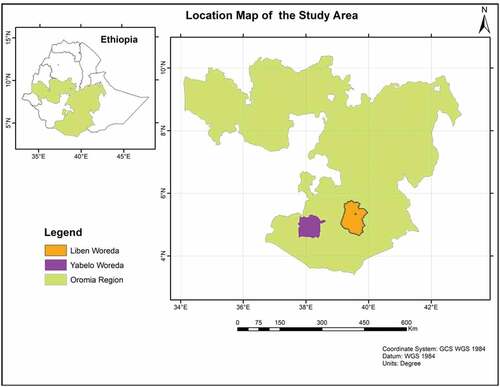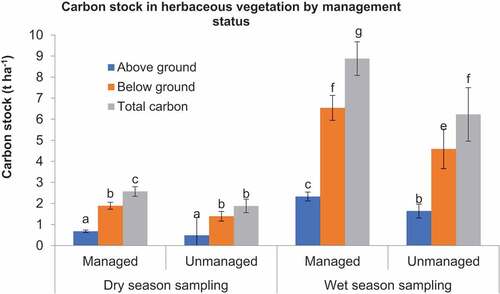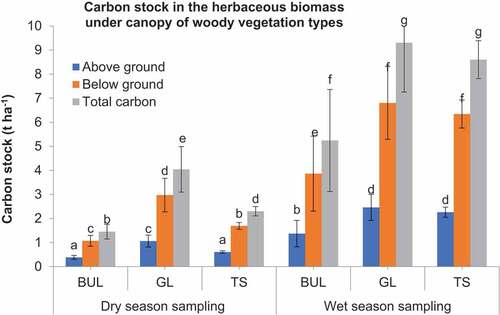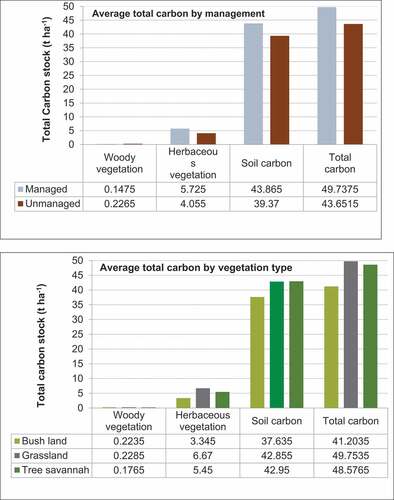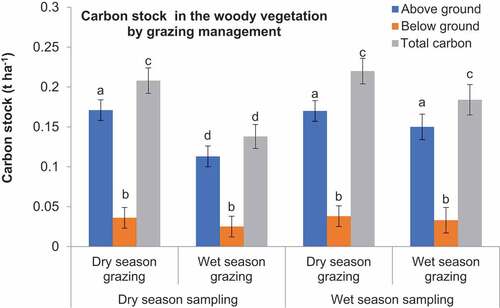 ?Mathematical formulae have been encoded as MathML and are displayed in this HTML version using MathJax in order to improve their display. Uncheck the box to turn MathJax off. This feature requires Javascript. Click on a formula to zoom.
?Mathematical formulae have been encoded as MathML and are displayed in this HTML version using MathJax in order to improve their display. Uncheck the box to turn MathJax off. This feature requires Javascript. Click on a formula to zoom.ABSTRACT
Rangelands occupy more than half of the terrestrial ecosystems and their management has a significant impact on the global carbon cycle. They are often managed for pasture and forage for livestock. This study examined impact of grazing management practices on biomass and carbon stock in dry lowland rangelands. A systematic transect sampling was applied to measure vegetation data, and to collect soil and herbaceous samples from the field. Allometric and species-specific equations were used to determine the woody biomass. Herbaceous biomass and soil carbon were analyzed in a laboratory. The results showed that herbaceous vegetation accounted for 5–15% of the total carbon stock while the woody vegetation accounted only for 0.3–1% of the total carbon stock. The soil is the largest carbon pool holding more than 90 % of the total carbon. Enclosures and bush clearing favored more herbaceous growth and changed the vegetation dynamics. As a result, the grasslands sequestered significantly high (P < 0.05) amount of soil carbon compared to the bush lands and the tree savannah. The management practices improved total carbon sequestration by 12.2%—26% in the system. There is high seasonal dynamics in the herbaceous carbon with a significant increase (P < 0.5) during the wet season. Soil carbon showed an inverse relationship with stem density, soil bulk density and slope. Rainfall and altitude have a positive influence on soil carbon. Total carbon stock in the managed rangelands was 19.8% higher than in the unmanaged rangelands. It can be concluded that enclosures and bush clearing enhance soil carbon sequestration. At the estimated annual sequestration rate of 1.6–3.5 t CO2e ha−1 yr−1 into the soil and 2.2–5.6 t CO2e ha−1 yr−1 into the total carbon stock in the system, the rangelands can make significant contribution to climate change mitigation.
1. Introduction
Rangelands are uncultivated lands that are primarily used for grazing and browsing of livestock and wild animals (Follet and Reed, Citation2010, Spangler et al., Citation2011). Rangelands globally cover over half of the terrestrial ecosystems, and hold significant importance for societal well-being (Engler et al., Citation2018; Lipper et al., Citation2010). In Africa, 43% of the total inhabited areas are rangelands (Bationo et al., Citation2015), and millions of pastoralists and agro-pastoralists rely on these resources for their livelihoods (J. Ellis & Galvin, Citation1994). Rangelands are rapidly decreasing due to degradation caused by anthropogenic and natural factors (Angasa and Oba, Citation2010; Chartier et al., Citation2013; Musa et al., Citation2016; Birhane, Citation2017; Engler, Citation2018). Fast growing human and livestock population exerted huge pressure on the resources and in some cases resulted in habitat change and ecological transformation (Spottiswoode et al., Citation2009). A decade ago, the global Land Degradation Assessment in Dry Lands reported severe degradation of 16% of the rangelands (Bai et al., Citation2008). Overgrazing is singled out as key factor contributing to 7.5 % of rangeland degradation (Onatibia & Aguiar, Citation2016). In Africa, 10.4% of grasslands are “overgrazed”, and much of this is found in Eastern and southern Africa (Conant & Paustian, Citation2002).
Overgrazing affects soil organic carbon by reducing biomass return to the soil (Angasa et al., Citation2012). It exposes the soil for erosion (Chartier et al., Citation2013), causes soil compaction, increases runoff, reduces infiltration (Chartier et al., Citation2011) and limits plant productivity in rangelands (Onatibia & Aguiar, Citation2016). Grazing management has a direct impact on primary productivity and carbon stock dynamics in rangelands (Bagchi & Ritchie, Citation2010; Bationo et al., Citation2015; Onatibia & Aguiar, Citation2016; Raiesi & Riahi, Citation2014). Grazing management also increases forage production, improves resource use efficiency and arrests degradation (Bailey et al., Citation2019). Nevertheless, the impact on carbon sequestration and storage is often neglected (Hiernaux et al., Citation1999). Rehabilitating overgrazed rangeland into moderate status could improve carbon sequestration by a conservative rate of 0.21MgCha−1 yr−1 (Conant & Paustian, Citation2002). Grazing management alters vegetation composition and structure (Argaw et al., Citation1999; Bailey et al., Citation2019), and the dynamics in carbon pools (Raiesi & Riahi, Citation2014; Conant et al., Citation2017). Grasslands with trees can store 30 t C ha−1 in Above Ground Biomass (AGB) while grasslands without trees store only 1.8 t C ha−1 (Grace et al., Citation2006).
Modification of the woody or herbaceous vegetation strongly affects the carbon pools. Not only management but also natural factors such as climate, topography, soil and vegetation types influence carbon dynamics (Dalle et al., Citation2014; Peri et al., Citation2016). The impacts of various management practices on carbon stock are well documented (Lipper et al., Citation2010; Dean et al., Citation2014; Peri et al., Citation2016; Conant et al., Citation2017; Maillard et al., Citation2017), while those of Enclosures and bush clearing are not adequately addressed (Bikila et al., Citation2016; Yayneshet et al., Citation2009). These two practices are increasingly adopted to rehabilitate rangelands in Sub-Saharan Africa (Verdoodt et al., Citation2009; Angasa et al., Citation2012; Aynekulu et al., Citation2017). Enclosures vary in size, purpose and ownership in different places (Feyisa et al., Citation2017). Small private enclosures are used for grazing of calves, sick animals, and as source of hey for cut-and-carry, while large enclosures are often communal and commercial (Angassa and Oba, Citation2010). Studies showed that Enclosures store more AGB and soil carbon than open grazing lands (Milne et al., Citation2015; Yayneshet & Treydte, Citation2015).
The Borana rangelands in southern Ethiopia suffered from bush encroachment and agricultural clearing (Dalle et al., Citation2006; Angassa and Oba, Citation2010). Population increase and expansion of Enclosures triggered intense grazing in limited areas, leading to bush encroachment and changes in species composition (Birhane et al., Citation2017). The desirable herbaceous perennials are replaced by annuals and woody species (Dalle et al., Citation2005). The herbaceous perennials are very important for livestock because they are always ready to green up and grow in events of small quantities of rainfall (Coppock, Citation1994; Sintayehu et al., Citation2006). On the contrary, annuals require more rain over extended periods of time to thrive compared to perennials. Hence, perennials are more reliable source of green forage at critical times of the year. Because of the shift from desirable forage grasses to encroaching bushes (Abule et al., Citation2007), the land available for grazing is increasingly reduced and livestock have a limited communal grazing area (Angassa and Oba, Citation2010). The carrying capacity is overstretched and livestock are forced to graze in smaller plots for longer periods of time (Bailey et al., Citation2019). Overgrazing and loss of herbaceous cover increased invasive infestation by 20–50% and reduced grassland cover by 37% in three decades (Sintayehu et al., Citation2006). In order to improve the rangeland resources in Borana, Enclosures, bush clearing and other management practices have been implemented in the past decades (Skinner, Citation2010; Napier and Solomon, Citation2011). The vegetation types and the composition in rangelands can be changed or modified because of grazing management and other natural factors (Aynekulu et al., Citation2017; Dalle et al., Citation2006). If stem density and canopy cover of woody species changes, so does the herbaceous cover and the carbon stock (Abule et al., Citation2005). This is a phenomenon in the Borana rangelands because of enclosures and bush clearing (Dalle et al., Citation2006). The woody components in Enclosures are regularly removed (Angassa and Oba, Citation2010), through mechanical means and burning to suppress encroaching bushes/trees (Coppock, Citation1994) and to invigorate grass growth. Burning is still an important tool for bush control in Borana rangelands (Skinner, Citation2010). Grazing management through livestock exclusion and bush clearing affects carbon sequestration (Bagchi & Ritchie, Citation2010). Besides, environmental factors such as climate, topography, vegetation types influence carbon stocks (Leeuw and Tothill, Citation1990; Schuman et al., Citation2002). The aim of the study was to investigate the impact of enclosures and bush clearing grazing management practices on carbon sequestration in arid and semi-arid rangelands of Borana. The null hypothesis is that management practices such as enclosures and bush clearing do not have significant impact on the different carbon pools and carbon stock of the grazing system. The alternative hypothesis is that management practices can enhance carbon sequestration in the grazing systems. The research tries to answer the questions “Do management practices make a difference in the carbon stock of the different carbon pools in the grazing systems?” and “What factors contribute to carbon enhancement in the grazing systems?”. Understanding the impact of management practices on carbon sequestration contributes to better management of rangelands and climate change mitigation.
2. Materials and methods
2.1. Study area description and location
The study was conducted in the Yabelo and LIben Woredas (i.e. districts) in the Borana rangelands of Southern Ethiopia located in between 38° E to 40° E and 4° N to 6° N (). Since grazing management practices, particularly seasonal grazing, enclosures and bush clearing are widely implemented in Yabelo and Liben districts, the Gomole and Dida Dheeda management units with respective area of 695,000 ha and 340,000 ha, were selected from the districts. They are about 85 km apart. The management practices have been applied for more than three decades (Angasa and Oba, Citation2010). The rangeland systems are traditionally sub-divided into dry and wet seasons grazing sub-units. The vegetation in Gomole is characterized by Acacia woodland in the lower plains and dry evergreen Juniper thickets in the upper altitudes. The study focused on the dry lowland rangelands. The agro-ecology is moist kolla and topography is undulating plains (Ridgewell et al., Citation2007). The mean annual rainfall in Gomole is 560 mm; soils are sandy and poor in organic matter. The Dida Dheeda rangeland unit has 700 mm annual rainfall and it is flat terrain (Dalle et al., Citation2006) with dense grass cover and sparse trees of Acacia and shrub species. The natural vegetation is well managed with Ranches and large Enclosures. Soils are black and deep clay in some areas while red and sandy in others (Aynekulu et al., Citation2017). The open grazing fields are degraded and restricted to the undulating foothills. In both grazing systems, management practices such as Enclosure of degraded areas, clearing of bushes, segregating dry and wet season grazing units, encouraging hey production for cut-and-carry, and water well rehabilitations were implemented in the past decades.
2.2. Description of the vegetation
It is imperative to describe the characteristic vegetation types before sampling. From the descriptions and classification of the semi-arid tropical savannah rangelands in literature (Pratt and Gwyne, Citation1977; Breuer, Citation2012; Pfister et al., Citation2013; White, Citation1983), three vegetation types were identified in the study area of the Borana rangelands. The first is Tree Savannah (TS), characterized by sparsely dispersed trees of different species with a relatively dense herbaceous cover. This is similar to wooded grassland in Pratt and Gwyne (Citation1977), having dense grass cover with scattered trees of < 20% canopy cover. The second is Bush land (BUL), which has thickets of bushes and shrubs with very thin and sparse herbaceous cover on the soil surface. The canopy is relatively high with <40% cover. Third is Grassland (GL) vegetation type, with open grass fields interspersed with few trees covering < 2% of the canopy. The ground surface is densely covered by herbs and forbs. The sampling was done in these vegetation types.
2.3. Management status and seasonal grazing units
The rangeland vegetation was categorized by management status and seasonal grazing. The rangelands under protection through Enclosures, ranches, sanctuaries, controlled grazing and hay production were considered as managed grazing lands. The managed rangelands have been under management for the last 30 years and above (Angasa and Oba, Citation2010). Those rangelands that are openly/freely accessed by community members, overgrazed and eroded were considered unmanaged rangelands. The field sampling was conducted based on this category. Traditionally, rangelands in Borana are divided as wet season and dry season grazing lands. The division is due to the uneven spatial distribution of water sources for livestock. In the dry season, livestock are kept near permanent water sources (ponds, wells and rivers) so that they don’t travel long distances in search of water. In the wet season, livestock are taken far away from permanent water sources to areas with better pasture and water is available from rains. This seasonal grazing pattern influences the carbon stock dynamics in the different pools. Therefore, seasonally grazed rangelands were sampled separately within the managed and unmanaged grazing lands.
2.4. Vegetation and soil sampling
Measurement of woody vegetation attributes (diameter and height), herbaceous biomass and soil samples collection was carried out by applying a systematic transect sampling technique. Transect sizes varied from 0.5 to 3 km depending on the size of the sampled area and barriers along the traverse. Distance between transects was 500 m. Data measurement and sampling were done in quadrate plots of 30 m X 30 m, systematically distributed at 200-m interval along transect lines (). The first quadrate was laid 100 m away from the edge of the vegetation. A total of 200 quadrates (100 in each site) were laid along 40 different size transects in each study site.
Figure 2. Schematic diagram showing transects and plots layout for woody vegetation, herbaceous vegetation and soil sampling.
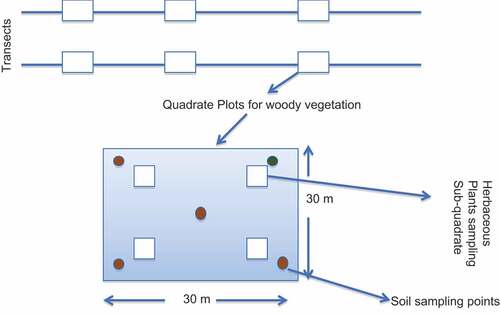
2.4.1. Woody vegetation data measurement
Vegetation data were measured in the dry and wet seasons. In each 30 m x 30 m quadrat plot, trees and shrubs were first identified by the local names and botanical names if known. Each tree was measured for DBH (Diameter at Breast Height) at 1.3 meter height and each shrub was measured for DSH (Diameter at Stump Height), at 20 cm from the soil surface. Height of trees and shrubs were measured using Sunnto clinometers. For unidentified trees and shrubs, leaf and flower specimens collected, pressed and dried for identification at the national Herbarium in Addis Ababa University. For the wet season sampling, plot coordinates were recorded using Garmin III GPS.
2.4.2. Herbaceous vegetation sampling
A sub-quadrate plot of 1 m X 1 m was used to collect samples of the above ground herbaceous vegetation at the corners within the main quadrate plot. All the herbaceous biomass in the sub-quadrat was collected using spade and pocket knife. Each sample was measured for fresh weight using hand-held digital-scale balance. A 100 g sub-sample was placed in a plastic bag with the sample labels for analysis at the soil laboratory of Water Works Design Enterprise in Addis Ababa. The herbaceous sub-samples were dried and ground for moisture content analysis and oven dry weight measurement in the laboratory. The ground sub-samples were placed in an oven at a temperature of 75 °C to determine the oven dry weight. Herbaceous cover was estimated using a 1 m X 1 m quadrate frame.
2.4.3. Soil sampling
Soil samples were collected from four corners and the center of the main plot using a 30 cm soil auger. The five sub-samples were mixed together and after removing the rocks, 1 kg composite soil sample was submitted for analysis. Soil core samples were collected using a bulk core sampler of 10 cm diameter and 5 cm length at the soil depth of 10 cm and 30 cm from the soil surface. The auger samples and core samples were analyzed for organic matter content and bulk density, respectively, at the soil laboratory of the Water Works Design Enterprise in Addis Ababa.
2.4.4. Dry and wet season sampling
The field sampling campaign was carried out in the dry and wet seasons to examine the seasonal dynamics of the carbon stock in the different pools. The dry season sampling was conducted in the period between March and May. The wet season sampling was conducted between end of August and September. During the wet season sampling, sampling quadrates were located using the spatial coordinates recorded in the dry season using a Garmin III GPS. Measurements were made in the same locations and plots.
2.4.5. Woody biomass estimation
The above-ground biomass of trees and shrubs was estimated using general allometric equation for trees and species-specific equations for lowland shrubs established by the national biomass inventory of Ethiopia, i.e. “Manual for Woody Biomass Inventory for Ethiopia” (MoA, Citation2000). The following allometric equations (Equ. 1) and species-specific (Equ.2) were used to determine the above ground biomass of trees and shrubs (Brown, Citation1997; MoA, Citation2000; Pearson et al., Citation2005):
Where Y is above ground biomass (ABG), DSH is diameter at stump height and r is radius or DBH/2. The below-ground biomass of trees and shrubs was calculated using the allometric equation developed for tropical tree and shrub species (Pearson et al., Citation2005):
Where BGB is belowground biomass and AGB is aboveground biomass (t ha−1)
2.4.6. Herbaceous vegetation biomass estimation
The above ground biomass of the herbaceous vegetation was determined from the oven dry weight of the herbaceous sub-samples, which is converted to total dry biomass weight per unit area (t ha−1) using the equation shown below (Pearson et al., Citation2005).
The total biomass density (t ha−1) was calculated using the expansion factor of 10,000 m2/area of the plot, which is 900 m2. The below ground biomass of the herbaceous vegetation was determined using the default expansion factor of Root/shoot ratio for semi-arid dry tropical grassland, which is a value of 2.8 (IPCC, Citation2003 Good Practice Guideline, GPG; IPCC, Citation2006, GPG).
2.4.7. Carbon stock estimation in woody and herbaceous biomass
The total carbon stock in the woody and herbaceous vegetation was calculated from the total biomass by using the default biomass expansion factor of 0.475, as given in the in the IPCC (Citation2003) Good Practice Guideline.
2.4.8. Soil organic carbon estimation
The percent soil organic carbon was determined in the laboratory using the Walkley Black method. The total soil carbon stock density was calculated using the measured bulk density of the soil and sampling depth (Pearson et al., Citation2005). The soil carbon density was calculated as follows:
Where SOC is the soil organic carbon (t ha−1) in the sub-sample and the BD is the bulk density (kg m3) of the soil and depth is the soil sampling depth, which is 30 cm.
2.4.9. Total carbon stock estimation
The total carbon stock density in the rangeland was estimated by summing up the carbon stock in the different carbon pools of the rangeland as shown below.
Where TC is total carbon in 1 ha of the rangeland, CWV is carbon in the woody vegetation, CHV is carbon in the herbaceous vegetation and CS is carbon in the soil pool. The atmospheric carbon dioxide equivalent (CO2e) of the total carbon mass was calculated by multiplying the total mass of carbon by the atomic weight ratio of carbon and oxygen, which is 44/12 or 3.67.
2.5. Statistical analysis
Data were organized and analyzed using SPSS software20.0. Variations in carbon stock in the different carbon pools, herbaceous cover and soil carbon among the managed and unmanaged systems, among the different vegetation types, the seasonal grazing systems were tested using ANOVA. Mean separation tests were conducted using the LSD (Least Significant Difference) technique in the SPSS. The relationship and trend analysis between soil carbon density and other variables such as stem density, herbaceous cover, soil bulk density, slope and other environmental variables were assessed using scatter plot dispersion.
3. Results
3.1. Gomole grazing system
3.1.1. The woody species composition
The Gomole rangeland unit has diverse composition of trees and shrubs, most of which are non-native to the locality (encroacher) species (Table ). A total of 1350 stems of trees and shrubs were recorded with a density of 150 stems ha−1. Commiphora africana, Acacia drepanolobium and Acacia seyal were the most aggressive encroacher tree species recorded in the rangeland unit. Over 58% of the tree species were identified as non-native encroachers in the rangeland (Table ). The dominant shrubs were the native or non-encroacher species of Euclea schimperi and Rhus vulgaries (Table ). The top three encroacher shrubs were Acacia brevispica, Acacia mellifera and Dichrostachys cinerea in that order (Table ). About 45.4% of the recorded shrubs are known encroachers in the rangeland.
Table 1. Type, status and number of stems of trees and shrubs recorded in Gomole
3.1.2. Carbon stock in the woody vegetation
The average total carbon stock in the woody biomass was less than 0.4 t ha−1 (). There was significantly higher (P < 0.001) woody biomass carbon in the unmanaged rangelands than in the managed rangelands (). This could possibly be related to the continuous removal of undesirable encroacher bushes, shrubs and trees in the managed rangelands. In the enclosures, bushes are regularly removed manually and large sized stems are thinned. Only 60 stems with a DBH of > 15 cm were recorded in the managed rangelands compared to 162 stems with a DBH of > 15 cm in the unmanaged rangelands. There was no seasonal variation (P > 0.001) in the above, below and total carbon stock of the woody vegetation (, same letters indicate no variation).
Figure 3. Carbon stock in the woody vegetation by management status measured in the dry and wet seasons (letters on error bars indicate significant difference at α = 0.001).
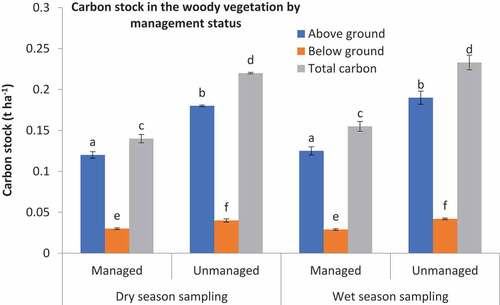
Figure 4. Carbon stock in the woody vegetation by seasonal grazing management measured in the dry and wet seasons (letters on error bars indicate significant difference at α = 0.001).
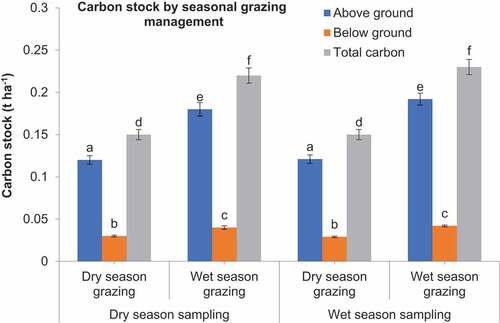
Wet season grazing lands accumulate significantly high carbon stock compared to the dry season grazing lands (P < 0.001, ). There was no significant variation in the above, below ground, and total carbon stock measured in the dry and wet seasons (P > 0.1; ).
3.1.3. Herbaceous cover and carbon stock by management status
The herbaceous cover is an important factor for the carbon stock in the above and below ground biomass. A significantly high herbaceous vegetation cover was recorded in the managed rangelands (P < 0.0001, ). The average herbaceous cover was 67 % in the managed rangelands while it was only 22% in the unmanaged rangelands. It is evident that grazing management effectively contributes to a significant increase in herbaceous cover in the managed rangelands. The herbaceous cover remained low in the unmanaged rangelands during the dry and wet seasons compared to the managed rangelands (). Since the wet season triggers growth, the herbaceous cover was significantly improved in the unmanaged rangelands during the wet season ().
Figure 5. Herbaceous vegetation cover in the managed and unmanaged rangelands measured in the dry and wet seasons (letters on error bars indicate significant difference at α = 0.05).
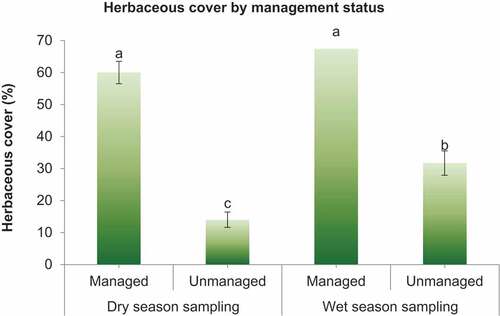
The carbon stock in the herbaceous vegetation showed similar pattern to the biomass. The total carbon stock in the managed rangelands was significantly higher (P < 0.05) than in the unmanaged rangelands (). The average total carbon stock in the herbaceous vegetation was 5.7 t ha−1 and 4.1 t ha−1 in the managed and unmanaged rangelands, respectively. The seasonal sampling showed a significant increase in the herbaceous carbon stock in both the managed and unmanaged rangelands (P < 0.05, ). The increase in the wet season was about 55% in both the managed and unmanaged rangelands.
3.1.4. Herbaceous cover and carbon stock by vegetation type
In rangelands, the type and density of the woody vegetation determines the cover and growth of the herbaceous vegetation beneath the canopy. Dense bushy vegetation is poor in herbaceous cover because it hinders the growth of grasses under its canopy due to obstruction of light and moisture competition. The herbaceous cover in the bush land (BUL) was significantly lower by 30% and 60% compared to the tree savannah (TS) and the grassland (GL) vegetation in the dry season (P < 0.05, ). The herbaceous cover significantly increased in the wet season by 27%, 11% and 15% in the BUL, GL and TS, respectively (P < 0.05, ) with a significant variation among the vegetation types.
Figure 7. Herbaceous cover by vegetation types (BUL = bush land; GL = grassland; TS = tree Savannah) measured in the dry and wet seasons (letters on error bars indicate significant difference at α = 0.05).
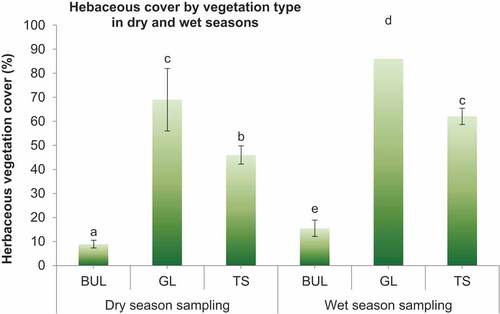
The average total carbon stock of the herbaceous biomass measured in the woody vegetation types was 3.3 t ha−1 in the BUL, 5.4 t ha−1 in the TS and 6.7 t ha−1 in the GL. In the dry season, the carbon stock was significantly less in the BUL by an amount of 64% and 37% from the GL and the TS, respectively (P < 0.05, ). In all the three vegetation types, the herbaceous vegetation carbon significantly increased in the wet season by a magnitude of 39%-58%, with a significant variation among the vegetation types (P < 0.05, ).
3.1.5. Soil carbon stock
The average total carbon stored in the soil was 42 t ha−1. In both the dry and wet season measurements, the soil carbon was significantly (P < 0.05) higher in the managed rangelands than in the unmanaged rangelands (Table ). The soil carbon within the same management system did not show seasonal variation (Table ). The GL vegetation had a significantly higher soil carbon than the BUL and the TS in the dry season. The TS showed significantly higher carbon stock than the BUL and GL in the wet season (P < 0.001, Table ). The dry season grazing lands accumulated significantly higher soil carbon than the wet season grazing lands (P < 0.01, Table ).
Table 2. Mean (±SE) soil carbon stock in Gomole rangeland grazing system by management status, woody vegetation types and seasonal grazing as measured in the dry and wet seasons (n = 94)
3.1.6. Total carbon stock and annual sequestration rate in the Gomole rangeland system
The average total carbon stock in the above and below ground biomass of the vegetation and in the soil pool was 46.67 t ha−1. The results generally show that the contribution of the woody vegetation to the total carbon stock and sequestration in rangelands is insignificant compared to the herbaceous and soil carbon pool. The herbaceous biomass is critically important to improve the carbon sequestration potential of rangelands. This is also evident from the analysis that the total average carbon stock in the grasslands was higher than in the bush lands and tree savannahs (). Management has improved the total carbon stock in the system by about 12.2%. In the managed rangelands, the annual rate of carbon sequestration in the last 10 years in the soil and in the total carbon pool has been 1.6 and 2.2 tCO2e ha−1 yr−1, respectively.
3.2. Dida Dheeda grazing system
3.2.1. Woody species composition
The Dida Dheeda grazing system is dominated by grasslands with very few scattered trees and shrubs compared to the Gomole grazing system. The unit is largely managed under enclosures of private and commercial nature. A total of 496 stems of trees and shrubs were recorded from the sampled areas (Table ), with a density of 55 stems/ha, which is 65 % less compared to that of Gomole. The two most encroacher species were A. drepanolobium and A. seyal followed by A. nilotica and C. africana (Table ). From the shrub species, L. floccosa was the top encroacher species after R. vulgaries, M. senegalensis and A. mellifera (Table, 3).
Table 3. The common tree and shrub species and total number of stems recorded from the sampled areas in the Dida Dheeda grazing system
3.2.2. Carbon stock in the woody vegetation
As the woody component is very thin in this grazing system, the average carbon stock was less than 0.20 t ha-1, showing that the woody contribution to the carbon stock in this system is minimal. In the managed rangelands, a significantly higher carbon stock was recorded in the dry season (P < 0.05, ) compared to the unmanaged rangelands. The wet season measurement did not show significant variation of the carbon stock (P > 0.05, ) in the managed and unmanaged rangelands. Apparently, this could be a result of regular bush clearing in the managed system to facilitate herbaceous growth during the wet season.
Figure 10. Carbon stock in the woody vegetation by management status in Dida Dheeda rangeland grazing system measured in the dry and wet seasons (letters on error bars indicate significant difference at α = 0.05).
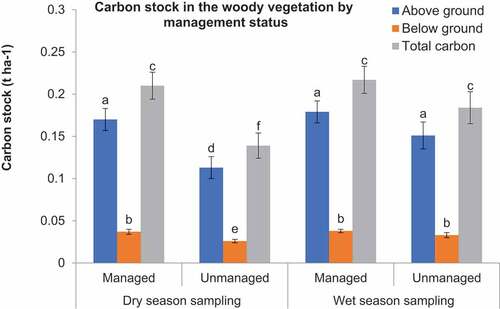
The carbon stock in the seasonal grazing lands corresponded with the managed and unmanaged rangelands (). The dry season grazing lands in the Dida Dheeda grazing system are mostly enclosures, strictly used in a controlled manner for grazing and hey production, and hence had significantly high carbon stock (P < 0.5, ). The number and types of grazing animals, the grazing intensity are controlled. However, on the contrary, the wet season measurement did not show any significant variation between the dry and wet season grazing lands, which might likely be resulted from measurement errors. It is unrealistic that the woody vegetation does show significant change in one season.
3.2.3. Carbon stock in the herbaceous vegetation
The herbaceous cover was higher in both the dry and wet seasons in the managed and unmanaged rangelands of the Dida Dheeda. The average cover was 88% in the managed rangeland and 48% in the unmanaged rangelands. There was no seasonal variation in the herbaceous cover of the managed rangeland (P > 0.05, ). However, a significant increase was observed in the unmanaged rangeland in the wet season (P < 0.05, ). This is highly likely due to the fact that the rangelands recover from the heavy grazing in the dry season and vigorously restore the herbaceous cover.
Figure 12. Herbaceous vegetation cover in the managed and unmanaged rangelands in Dida Dheeda grazing system measured in the dry and wet seasons (letters on error bars indicate significant difference at α = 0.001).
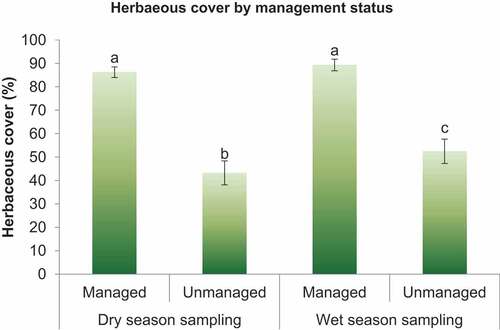
Enclosures and other management practices significantly improved the herbaceous carbon stock in the Dida Dheeda rangeland system (P < 0.001, ). Management significantly improved herbaceous carbon stock in both the dry and wet seasons (P < 0.001, ). Although the herbaceous carbon stock was significantly low in the unmanaged rangelands, a significant increase was observed in the wet season.
Figure 13. Herbaceous vegetation carbon stock in the managed and unmanaged rangelands in Dida Dheeda rangeland grazing system in the dry and wet seasons (α = 0.001).
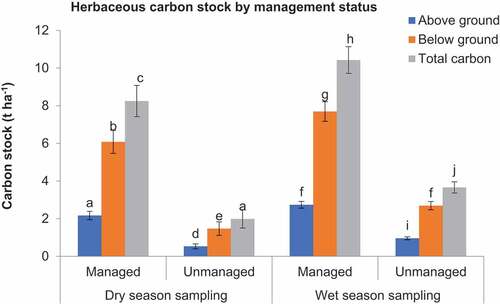
Woody vegetation types extensively vary in their undercover growth due to the variation in canopy cover. Hence, there was a significant variation in the herbaceous cover and the carbon stock among the vegetation types. Compared to the TS and BUL vegetation, the GL showed a significantly high herbaceous cover in both seasons by an average of 33% from the TS and 58% from the BUL (; P < 0.05). The seasonal difference was insignificant among the vegetation types.
Figure 14. Herbaceous vegetation cover in the woody vegetation types in the dry and wet seasons in Dida Dheeda (α = 0.05).
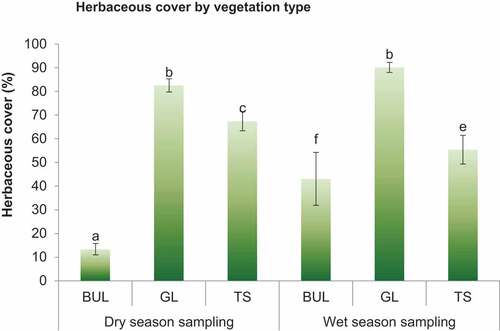
The average carbon stock in the herbaceous vegetation was 2.2 t ha−1 in the BUL, 9 t ha−1 in the GL and 3.9 t ha−1 in the TS. The BUL vegetation type generally suppresses undergrowth and often retains minimum in herbaceous cover under the canopy, which might be a result of light obstruction and root competition by the woody vegetation. In the wet season, the cover and carbon stock slightly improved in the grasslands and in the bush lands ().
3.2.4. Carbon stock in the soil pool
The average soil carbon stock was 47.7 t ha−1. Management and vegetation types contributed to the variation in the soil carbon. A significantly higher mean soil carbon was recorded in the managed rangelands than in the unmanaged rangelands (Table , P < 0.05). No seasonal variation was observed within the same management system (Table ). The vegetation types varied in their soil carbon. The GL had significantly high soil carbon (P < 0.5) and the BUL had the least soil carbon (Table ). The seasonal measurements did not show any variation. The dry season grazing lands had significantly higher soil carbon than the wet season grazing lands (P < 0.5, Table ).
Table 4. Mean (±SE) soil carbon stock (t ha−1) in rangelands by management status, vegetation types and seasonal grazing management in the dry and wet seasons in Dida Dheeda grazing system (n = 55)
3.2.5. Total carbon stock and annual sequestration rate in the Dida Dheeda grazing system
The woody biomass is the least contributor to the carbon sequestration potential of the rangelands. The average total carbon stock in the woody, herbaceous and soil pool are in the order of 0.18 t ha−1, 6.1 t ha−1 and 47.7 t ha−1. The total average carbon stock in the biomass (above and below ground) and soil pool of the rangeland is 54 t ha−1 (), which is 14% higher than that of the Gomole rangeland. Management makes a greater contribution to the improvement of the carbon sequestration potential of rangelands. In the Dida Dheeda rangeland, which is largely under managed system, the total carbon stock is 26% (or about 17 t ha−1) higher in the managed rangelands than that of the unmanaged rangelands (). The GL sequestered greater amount of carbon followed by TS and BUL (). The GL is, thus, the primary contributor to the carbon sequestration potential of rangelands. Moreover, management intervention considerably and progressively improves the sequestration potential of rangelands regardless of the seasons. In the managed rangelands, the annual rate of carbon sequestration in the last ten years was 3.3 and 5.6 t CO2e ha−1 yr−1 into the soil and into the total carbon pool, respectively.
4. Discussion
4.1. Grazing management practices and effect on carbon sequestration
The results in this study suggest that bush encroachment remains a serious challenge in the Borana rangelands, as it continues to affect rangelands in arid and semi-arid landscapes in Africa and elsewhere (Archer et al., Citation2017; Gobelle & Gure, Citation2018; Sandhage-Hofmann et al., Citation2020). In the Gomole and Dida Dheeda grazing systems, encroacher species were dominant and covered 45–58 % of the total recorded species. Encroacher species suppress the growth and composition of native species of grasses and forbs (Abule et al., Citation2005), and managing the encroaching shrub/tree species improves herbaceous biomass. The results conform to the findings reported in similar studies (Belay et al., Citation2013; Dalle et al., Citation2006; Gobelle & Gure, Citation2018) for the southern Ethiopia rangelands. The results proved that the hypothesis does not hold true and management practices induce significant changes in the carbon stock of the above and below ground carbon pools. The main management factors, i.e. bush clearing and enclosures, significantly altered the carbon dynamics in the herbaceous, woody and soil components. The high carbon stock in the herbaceous component and a significantly low carbon stock in the woody component in the managed system likely resulted from selective thinning of the encroaching shrub/tree stems in the enclosures (Gobelle & Gure, Citation2018).
The soil was found to be the largest carbon pool storing 89–95% of the total carbon stock in the southern rangelands. The results conform with studies that reported 90–98% of the total carbon in rangelands being stored in the soil pool (Schuman et al., Citation2002; Tennigkeit and Wilke, Citation2008). Much of this is found in the top 30 cm soil (Wang et al., Citation2018), which is prone to disturbances and perturbation. Grazing management practices alter above ground biomass and the top soil, both of which determine the carbon dynamics in the rangelands (Aynekulu et al., Citation2017). In Borana rangelands, Enclosures are the most common management practices, and help to limit grazing pressure by avoiding free grazing, reducing stocking rate and allowing stall feeding using cut-and-carry system (Feyisa et al., Citation2017). Besides, Enclosures favor herbaceous growth by reducing woody stems through bush clearing; and favor biomass return to the surface soil. In Gomole and Dida Dheeda grazing systems, the total carbon stock in the managed rangelands was 10% and 18% higher than in the unmanaged/ open grazing lands, respectively. This agrees with a study by Yusuf et al. (Citation2015) in Borana rangelands, who reported 49 t ha−1 more carbon in Enclosures than in open grazing lands. Annually, Enclosures in Gomole and Dida Dheeda grazing systems sequestered 1.6 tCO2e ha−1 yr−1 to the soil carbon and 3.5 tCO2e ha−1 yr−1 to the total carbon, respectively. Similar studies on rangeland Enclosures in China found an increase of carbon sequestration by a rate of 2.35–4.33 t CO2e ha−1 yr−1 after excluding grazing from degraded grasslands (Li et al., Citation2007; Zhou et al., Citation2007). After studying soil carbon sequestration potential in overgrazed grasslands, Conant and Paustian (Citation2002) concluded that reducing grazing pressure and implementing moderate intensity can improve carbon sequestration in grassland soils.
The notable effect of Enclosures was in the herbaceous biomass in both the Gomole and Dida Dheeda rangelands. An increase of 55% biomass or 0.37 t ha−1 in Gomole and 40% biomass or 3.4 t ha−1 in Dida Dheeda was recorded in the managed rangelands compared to the unmanaged. A similar study by Angasa and Oba (Citation2010) in Borana rangeland reported 64% more herbaceous biomass in enclosures than in open-grazed rangelands. Yusuf et al. (Citation2015) recorded a significantly high above and below ground herbaceous biomass and carbon in enclosures than in open-grazed lands in Borana. Not only in the arid and semi-arid rangelands but also similar results were reported for wet highlands. After studying 5–15 years of Enclosure in northern Ethiopia rangelands, Yayneshet et al. (Citation2009) observed 200% increase in herbaceous biomass compared to the unenclosed rangelands. Naturally, an increase in herbaceous cover and biomass enhances soil cover, litter fall and organic matter return to the soil. The results in this study showed a positive linear relationship between herbaceous biomass cover and soil carbon sequestration in Gomole and Dida Dheeda (). Whereas, an inverse relationship was observed between soil carbon and soil bulk density in both sites (). The soil bulk density is important indicator for soil physical quality and organic matter availability. Increased soil organic matter lowers the bulk density, increases soil pore spaces and improves air and water movement in the soil facilitating microbial activity for decomposition and carbon release to the soil. This suggests that management through enclosures improves the soil carbon stock (Raiesi & Riahi, Citation2014). Enclosures enable changes in the plant composition by favoring perennial grasses (i.e. C4 grasses), which are sturdy warm-climate plants (Coppock, Citation1994) and store large amount of carbon in the root biomass and later release the carbon to the soil through decomposition (McSherry & Ritchie, Citation2013).
Figure 17. Relationship between soil carbon stock and herbaceous biomass cover in the Gomole and Dida Dheeda grazing systems.
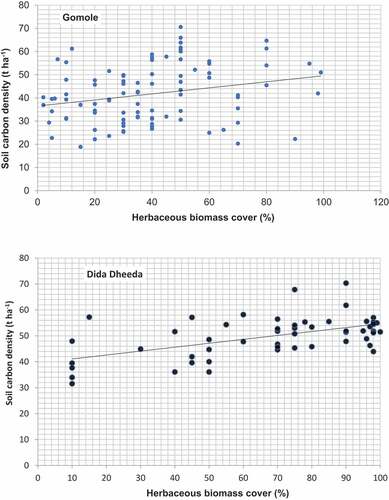
Figure 18. Relationship between soil carbon stock and soil bulk density in the Gomole and Dida Dheeda grazing systems.
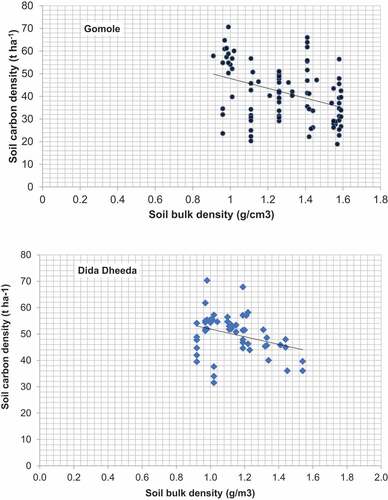
Enclosures in Borana serve as a system of seasonal grazing management. Enclosed rangelands are reserved for times of critical feed shortage, droughts and extended dry season. These are rangelands close to permanent or reliable water sources, settlements and rivers. Distance from water source is very important for grazing management. Thus, the dry season grazing rangelands are de facto managed rangelands. They are exposed to light or moderate grazing by small number of livestock. However, the wet season grazing rangelands are unmanaged rangelands, which are open for free access grazing. These rangelands are exposed to heavy grazing, high stocking rate and uncontrolled bush encroachment (Angassa et al., Citation2012). Although some studies claim that grazing enhances soil carbon through effect of livestock droppings and trampling (Aynekulu et al., Citation2017), our results show a reduced soil carbon stock and high woody stem density compared to the enclosed or dry season grazing rangelands.
Another important rangeland management practice in the Borana rangelands is Bush clearing. Farmers remove encroaching bushes, undesirable and low forage value species from the managed rangelands (mainly in enclosures or private Kallos and ranches. High stem density was recorded in Gomole than in Dida Dheeda, and the herbaceous biomass was 10–20% higher in Dida Dheeda. Unlike in Dida Dheeda, large part of the rangeland in Gomole is unmanaged and freely grazed by livestock, resulting in expansion of encroacher species of shrubs and trees in the rangeland. Tefera et al. (Citation2007) studied woody stem density in Borana rangelands and reported highest stem density of encroacher species in the free-grazed communal lands (i.e. unmanaged rangelands) and the least was recorded in the traditional enclosures, in which encroacher species such as A. brevisica was completely removed from the traditional enclosures (Kallos).
Bush clearing reduces stem density and enhances herbaceous biomass, depending on environmental factors such as climate and soil types. Drought and poor soils may inhibit vegetation growth in arid environments. An inverse relationship was observed between stem density and herbaceous biomass cover in both study sites. As stem density increased, herbaceous biomass cover declined. A similar relationship was reported by Yusuf et al. (Citation2015) in Borana and Abule et al. (Citation2005) in Afar rangelands. Both studies claimed that low herbaceous cover and low organic carbon stock was directly associated with high encroacher tree density. Leeuw and Tothill (Citation1990), in their assessment of the carrying capacity of African rangelands, found that increasing density of woody stems in rangelands substantially decreased the total dry matter production of herbaceous vegetation. The reduction ranged from 10% to 80% as reported in Kenya, Mali and Botswana for 40–90% increase in the woody stem density (Leeuw and Tothill,Citation1990). Although the woody components in rangelands are important providers of browse, our finding shows insignificant contribution to the total carbon sequestration. Our study also showed that, it is not the mere number of stems that actually matter for the total carbon sequestration in the system; rather the stem size is important. Few larger size stems can sequester and store more carbon than large number of small size stems in the rangelands.
4.2. Management practices, environmental factors and carbon sequestration
Although management practices improve biomass return and soil carbon sequestration, climate determines primary production, organic matter return and decomposition processes (Conant & Paustian, Citation2002; Tennigkeit and Wilke, Citation2008; Spangler et al., Citation2011; Dalle et al., Citation2014). The study areas varied in terms of mean annual rainfall, with 560 mm in Gomole and 700 mm in Dida Dheeda. The soil carbon values were higher in the Dhedaa grazing system than in Gomole grazing system (). Although this is subject to further study and verification, soil carbon sequestration in the study area is positively and significantly influenced by annual rainfall (). As it was observed in both the biomass and carbon stock values, management practices improved the soil carbon sequestration in the high rainfall areas, i.e. in Dida Dheeda rangelands by 18% or 9.5 t ha−1. This result agrees with findings of Leeuw and Tothill (Citation1990), who reviewed various literatures on dry matter production and mean annual rainfall in west and Eastern Africa. They reported an increasing dry matter production from 0.6 to 2.3 t ha−1 in rainfall regime of 200–400 mm and 1.7–3.7 t ha−1 in 600–800 mm rainfall regime. Schuman et al. (Citation2002) reported an increasing trend in soil organic carbon with a change of rainfall from 200 mm to 350 mm in semi-arid grassland in the central US. Conant and Paustian (Citation2002) tried to model global scale soil carbon sequestration in degraded rangelands and found that greater amount of soil carbon sequestration took place in high rainfall and wet areas than in low rainfall and dry areas. Altitude is another factor that showed positive relationship with soil carbon sequestration. Much of the carbon is concentrated in the mid altitude areas than the low and high altitude areas. The low altitude areas exhibited low soil carbon stock and only few outliers were observed in the higher altitude areas ().
Figure 19. Relationship between soil carbon stock, rainfall and altitude in the Gomole and Dida Dheeda grazing systems.

Topography (slope) is another factor that affects soil carbon sequestration in a number of ways. Slope influences runoff and facilitates erosion of top soil (carbon-rich soil). An inverse relationship was observed between slope and soil carbon sequestration (Fig. 21). The soil carbon stock showed a declining trend with an increasing slope in the landscape. This might be attributed to the soil type, top soil cover, soil erosion, rooting depth, aspect and others (Ardo & Olsson, Citation2003). The topography of the sampled rangelands in Gomole was undulating with slope of 0–30%. In Dida Dheeda, the landscape was gently flat with a slope range of 0–7% (Fig. 21). However, in both cases, large amount of the soil carbon was concentrated in the gentle to flat slope range (below 7%) (Fig.21). In Dida Dheeda, the rangeland has good herbaceous biomass cover, soil is loamy and slope is flat, which might collectively prevent soil erosion, runoff and carbon loss from the landscape. Soils with high clay content generally store high organic carbon (Tennigkeit and Wilke, Citation2008). Hence, it can be technically assumed that carbon stock change in a landscape could be a result of multiple environmental factors and not merely from change in management practices even though slope is inversely related (Fig. 21).
Literature generally suggests that generalizations on the impact of woody plant encroachment on ecosystem carbon balance are contentious and inconclusive for lack of sufficient data and information at the regional scale (Archer et al., Citation2017). Archer et al. (Citation2017) further argue that results on robust conclusions are constrained by the methodologies used to estimate soil organic carbon pools and how the soil pools respond to disturbance and management practices such as drought, wildfire, prescribed burning and bush clearing. Similarly, at ecosystem and habitat levels, there are conflicting reports of increase in carbon stock in some ecosystems and a decline in others. For instance, Sandhage-Hofmann et al. (Citation2020) found an increase in soil carbon in a woody plant encroached grazing land in South Africa. On the contrary, Belay et al. (Citation2013) reported no change in the carbon stock in bush encroached rangeland compared to non-encroached parts in South Ethiopia. An interesting comparative study by Gobelle and Gure (Citation2018) found that carbon stock was higher in the order of encroached > thinned-encroached > non-encroached rangelands. This shows that managing encroaching trees through removal (thinning) indeed reduces the carbon stock, which supports our finding here. Our findings indicate that managing encroaching species through removal and restricting livestock through enclosures reduces above ground biomass from bushes/trees but enhances carbon stock in the herbaceous component and the soil carbon stock. On top of management interventions, environmental factors play role in enhancing carbon stock in the above and below ground biomass.
5. Conclusion
Grazing management practices alter the composition, structure and biomass dynamics in the above ground vegetation of the lowland rangelands. Significant numbers of Encroaching bushes and trees exist in the standing vegetation and still cause serious threats to forage availability for livestock. Enclosures reduce the grazing pressure and clearing the encroaching bushes and trees improve herbaceous cover and growth. These practices are widely implemented in the Gomole and Dida Dheeda grazing systems of the Borana rangelands. As the woody stems are continuously removed from the enclosures, the woody vegetation is the least contributor to the total carbon sequestration in the system while the herbaceous component is the largest contributor next to the soil carbon. The vegetation types differ in their carbon stocks. The bush lands stored less amount of soil carbon compared to the tree savannah and the grasslands. However, the grasslands sequestered the largest amount of soil carbon in the grazing system. This could be perhaps attributed to the high root biomass growth of the warm-climate (C4) perennial grasses that thrived after the enclosures. The rangeland soil is the main carbon pool and holds more than 90% of the total carbon. Management practices significantly improved carbon sequestration in the grazing systems, mainly by enhancing soil carbon. The soil carbon and the woody biomass did not show seasonal variation. As the data was a single season observation, the result could be different if seasonal observations are increased. Woody stem density, soil bulk density and topography/slope are linearly and inversely related to soil carbon. With a steady increase of annual rate of carbon sequestration, the rangelands greatly contribute to climate change mitigation.
Public Interest Statement
Lowland range lands are home for significant numbers of pastoral and agro-pastoral communities in Africa and these range lands are often neglected in putting the right management in place. Free and open grazing of livestock has persisted for generations and left some of the critical range lands under serious state of degradation. Over grazing and bush encroachment are the main causes of degradation. Traditionally, enclosures are applied to manage the grazing systems and to control bush encroachment through mechanical removal. Such practices change the vegetation composition and structure, the soil organic matter and carbon dynamics. These management practices not only improve pasture for livestock but also significantly increase carbon sequestration in the soil as well as in the range land systems. Managing range lands have a long term positive impact for climate change mitigation.
Acknowledgements
The author would like to thank the two PhD students (Tulu and Abraham) who have helped in the collection of the field data and organizing the soil and biomass samples for laboratory analysis. The lab technicians at the Water Works Design Enterprise provided all the necessary support and cooperation in analyzing the samples and delivering the results. The local experts and farmers excellently facilitated the field work and they deserve sincere thanks and appreciation.
Disclosure statement
No potential conflict of interest was reported by the author(s).
Data availability statement
The data that support the findings of this study are available from the corresponding author, MA upon reasonable request.
Additional information
Funding
Notes on contributors
Mekuria Argaw Denboba
Mekuria Argaw is an associate professor of Ecology and Environmental Sciences, at the Center for Environmental Science, College of Natural and Computational Science, Addis Ababa University, Addis Ababa, Ethiopia. He teaches MSc and PhD courses, advises and mentors PhD and MSc students. He has 20 years of teaching experience and authored and co-authored peer reviewed journal articles in wide range of environmental topics.
References
- Abule, E., Smith, G. N., & Snyman, H. A. (2005). The influence of woody plants and livestock grazing on grass species composition, yield and soil nutrients in the Middle Awash Valley of Ethiopia. Journal of Arid Environments, 60(2), 343–24. https://doi.org/10.1016/j.jaridenv.2004.04.006
- Abule, E., Snyman, H. A., & Smit, G. N. (2007). Rangeland evaluation in the middle Awash valley of Ethiopia: II. Woody vegetation. Journal of Arid Environments, 70(2), 272–292. https://doi.org/10.1016/j.jaridenv.2007.01.007
- Angassa, A., & Oba, G. (2010). Effects of grazing pressure, age of enclosures and seasonality on bush cover dynamics and vegetation composition in southern Ethiopia. Journal of Arid Environments, 74(1), 111–120. https://doi.org/10.1016/j.jaridenv.2009.07.015
- Angassa, A., Sheleme, B., Oba, G., Treydte, A. C., Linstädter, A., & Sauerborn, J. (2012). Savanna land use and its effect on soil characteristics in southern Ethiopia. Journal of Arid Environments, 81, 67–76. https://doi.org/10.1016/j.jaridenv.2012.01.006
- Archer, S. R., Andersen, E. M., Predick, K. I., Schwinning, S., Steidl, R. J., & Woods, S. R. (2017). Woody plant encroachment: Causes and consequences. In D. D. Brieske (Ed.),Rangeland systems: Processes, management and challenges. Springer Open 643 . https://doi.org/10.1007/978-3-319-46709-2
- Ardo, J., & Olsson, L. (2003). Assessment of soil organic carbon in semi-arid Sudan using GIS and the CENTURY model. Journal of Arid Environments, 54(4), 633–651. https://doi.org/10.1006/jare.2002.1105
- Argaw, M., Teketay, D., & Olsson, M. (1999). Soil seed flora, germination and regeneration pattern of woody species in an Acacia woodland of the Rift Valley in Ethiopia. Journal of Arid Environments, 43(4), 411–435. https://doi.org/10.1006/jare.1999.0532
- Aynekulu, E., Mekuria, W., Tsegaye, D., Feyissa, K., Angassa, A., de Leeuw, J., & Shepherd, K. (2017). Long-term livestock exclosure did not affect soil carbon in southern Ethiopian rangelands. Geoderma, 307, 1–7. https://doi.org/10.1016/j.geoderma.2017.07.030
- Bagchi, S., & Ritchie, M. E. (2010). Introduced grazers can restrict potential soil carbon sequestration through impacts on plant community composition. Ecology Letters, 13 , 959–968. https://doi.org/10.1111/j.1461-0248.2010.01486.x
- Bai, Z. G., Dent, D. L., Olsson, L., & Schaepman, M. E. (2008). Global assessment of land degradation and improvement 1: Identification by remote sensing. Report 2008/01, ISRIC – World Soil Information.
- Bailey, D. W., Mosley, J. C., Estell, R. E., Cibils, A. F., Horney, M., Hendrickson, J. R., Walker, J. W., Launchbaugh, K. L., & Burritt, E. A. (2019). Synthesis paper: Targeted livestock grazing: Prescription for healthy rangelands. Rangeland Ecology & Management, 72(6), 865–877. https://doi.org/10.1016/j.rama.2019.06.003
- Bationo, A., Reid, R., & Sift, D. (2015). Current types of grazing lands in Sub-Saharan Africa and associated management practices. In E. Milne, D. Hoag, & R. Bowen (Eds.), Grazing lands, livestock and climate resilient mitigation in Sub-Saharan Africa: Part 1. The state of the science. IUCN 100 .
- Belay, T. A., Totland, Ø., & Moe, S. R. (2013). Ecosystem responses to woody plant encroachment in a semiarid savanna rangeland. Plant Ecology, 214(10), 1211–1222. https://doi.org/10.1007/s11258-013-0245-3
- Bikila, N. G., Tessema, Z. K., & Abule, E. G. (2016). Carbon sequestration potentials of semi-arid rangelands under traditional management practices in Borana, Southern Ethiopia. Journal of Arid Environments, 233 , 108–114 doi:http://dx.doi.org/10.1016/j.agee.2016.02.028.
- Birhane, E., Treydte, A. C., Eshete, A., Solomon, N., & Hailemariam, M. (2017). Can rangelands gain from bush encroachment? Carbon stocks of communal grazing lands invaded by Prosopis juliflora. Journal of Arid Environments, 141, 60–67. https://doi.org/10.1016/j.jaridenv.2017.01.003
- Breuer, B. (2012). Effects of vegetation type and species composition on carbon stocks in Semi-arid Ethiopian Savanahs [MSc thesis], University of Hohenheim.
- Brown, S. (1997). Estimating biomass and biomass change of tropical forests: A primer. FAO Forestry Paper 134, FAO, Rome, Italy.
- Chartier, M. P., Rostagno, C. M., & Pazos, G. E. (2011). Effects of soil degradation on infiltration rates in grazed semiarid rangelands of northeastern Patagonia, Argentina. Journal of Arid Environments, 75(7), 656–661. https://doi.org/10.1016/j.jaridenv.2011.02.007
- Chartier, M. P., Rostagno, C. M., & Videla, L. S. (2013). Selective erosion of clay, organic carbon and total nitrogen in grazed semiarid rangelands of northeastern Patagonia, Argentina. Journal of Arid Environments, 88, 43–49. https://doi.org/10.1016/j.jaridenv.2012.08.011
- Conant, R.T., Cerri, C.E.P., Osborne, B.B., and Paustian, K. 2017. Grassland management impacts on soil carbon stocks: a new synthesis. Ecological Applications, 27 (2), 662–668.
- Conant, R. T., & Paustian, K. (2002). Potential soil carbon sequestration in overgrazed grassland ecosystems. Global Biogeochemical Cycles, 16(4), 1143. https://doi.org/10.1029/2001GB001661
- Coppock, D. L. (1994). The Borana Plateau of Southern Ethiopia: Synthesis of pastoral research, development and change, 1980-91, ILCA Systems Study. International Livestock Centre for Africa (ILCA), Addis Ababa.
- Dalle, G., Maass, B. L., & Isselstein, J. (2005). Plant communities and their species diversity in the semi-arid rangelands of Borana lowlands, southern Oromia, Ethiopia. Community Ecology, 6(2), 167–176. https://doi.org/10.1556/ComEc.6.2005.2.5
- Dalle, G., Maass, B. L., & Isselstein, J. (2006). Rangeland condition and trend in the semi-arid Borana lowlands, southern Oromia, Ethiopia. African Journal of Range & Forage Science, 23(1), 49–58. https://doi.org/10.2989/10220110609485886
- Dalle, G., Maass, B. L., & Isselstein, J. (2014). Relationships between vegetation composition and environmental variables in the Borana Rangelands, Southern Oromia, Ethiopia. SINET: Ethiopian Journal of Science, 37(1), 1–12 https://www.ajol.info/index.php/sinet/article/view/111055.
- De Leeuw, P. N., & Tothill, J. ca. (1990 ()). The concept of rangeland carrying capacity in sub-saharan Africa: Myth or reality? Pastoral Development Network, ODI.
- Dean, C., Kirkpatrick, J. B., Harper, R. J., & Eldridge, D. J. (2014). Optimising carbon sequestration in arid and semiarid rangelands. Ecological Engineering, 74, 148–163. https://doi.org/10.1016/j.ecoleng.2014.09.125
- Ellis, J., & Galvin, K. A. (1994). Climate patterns and land-use practices in the dry zones of Africa. BioScience, 44(5), 340–349. https://doi.org/10.2307/1312384
- Engler, J. O., Abson, D. J., Feller, R., Hanspach, J., & von Wehrden, H. (2018). A social-ecological typology of rangelands based on rainfall variability and farming type. Journal of Arid Environments, 148, 65–73. https://doi.org/10.1016/j.jaridenv.2017.09.009
- Feyisa, K., Beyene, S., Angassa, A., Said, M.Y., Leeuw, J., Abebe, A., Megersa, B. 2017. Effects of enclosure management on carbon sequestration, soil properties and vegetation attributes in East African rangelands. Catena, 159, 9–19.
- Follett, R. F., & Reed, D. A. (2010). Soil carbon sequestration in grazing lands: Societal benefits and policy implications. Rangeland Ecology & Management, 63(1), 4–15. https://doi.org/10.2111/08-225.1
- Gobelle, S. K., & Gure, A. (2018). Effects of bush encroachment on plant composition, diversity and carbon stock in Borana rangelands, Southern Ethiopia. International Journal of Biodiversity and Conservation, 10(5), 230–245. https://doi.org/10.5897/IJBC2017.1143
- Grace, J., Jose, S. J., Meir, P., Miranda, H. S., & Motes, R. A. (2006). Productivity and carbon fluxes of tropical Savannas. Journal of Biogeography, 33, 387–400. https://doi.org/10.1111/j.1365-2699.2005.01448.x
- Hiernaux, P., Bielderst, C.L., Valentin, C., Bationo, A. and Fernandez-Rivera, S. 1999. Effects of livestock grazing on physical and chemical properties of sandy soils in Sahelian rangelands. Journal of Arid Environments, 41, 231–245.
- Intergovernmental Panel on Climate Change (IPCC). (2003). Good practice guidance for land use, land- use change and forestry IPCC/IGES (IPCC). J. Penman, M. Gytarsky, T. Hiraishi, T. Krug, D. Kruger, R. Pipatti, L. Buendia, K. Miwa, T. Ngara, K. Tanabe, & F. Wagner, Eds.
- IPCC. (2006). Guidelines for national greenhouse gas inventories – A primer, prepared by the national greenhouse gas inventories programme. H. S. Eggleston, K. Miwa, N. Srivastava, & K. Tanabe, eds. Published.IGES.
- Li, X. G., Wang, Z. F., Ma, Q. F., & Li, F. M. (2007). Crop cultivation and intensive grazing affect organic C pools and aggregate stability in arid grassland soil. Soil and Tillage Research, 95(1–2), 172–181. https://doi.org/10.1016/j.still.2006.12.005
- Lipper, L., Dutilly-Diane, C., & McCarthy, N. (2010). Supplying carbon sequestration from West African Rangelands: Opportunities and barriers. Rangeland Ecology and Management, 63(1), 155–166. https://doi.org/10.2111/REM-D-09-00009.1
- Maillard, E., McConkey, B. G., & Angers, D. A. (2017). Increased uncertainty in soil carbon stock measurement with spatial scale and sampling profile depth in world grasslands: A systematic analysis. Agriculture, Ecosystems & Environment, 236, 268–276. https://doi.org/10.1016/j.agee.2016.11.024
- McSherry, M., & Ritchie, M. (2013). Effects of grazing on grassland soil carbon: A global review. Global Change Biology, 19(5), 1347–1357. https://doi.org/10.1111/gcb.12144
- Milne, E., Hanan, N., Neely, C., & Williams, S. (2015). Carbon impacts of grazingland management systems and practices in Sub-Saharan Africa. In E. Milne, D. Hoag, & R. Bowen (Eds.), Grazing lands, livestock and climate resilient mitigation in Sub-Saharan Africa: Part 1. The state of the science. IUCN 100 .
- MoA. (2000). Manual for inventory of the woody biomass for Ethiopia. TECSULT Inc.
- Mussa, M., Hashim, H., & Teha, M. (2016). Rangeland degradation: Extent, impacts, and alternative restoration techniques in the Rangelands of Ethiopia. Tropical and Subtropical Agro-ecosystems, 19( Review paper), 305–318 https://www.researchgate.net/publication/317038054_Rangeland_degradation_Extent_impacts_and_alternative_restoration_techniques_in_the_rangelands_of_Ethiopia.
- Napier, A., & Desta, S. (2011). Review of pastoral Rangeland Enclosures in Ethiopia, PLI policy project; supported by Feinstein International Center. Tufts University and USAID.
- Onatibia, G. R., & Aguiar, M. R. (2016). Continuous moderate grazing management promotes biomass production in Patagonian arid rangelands. Journal of Arid Environments, 125, 73–79. https://doi.org/10.1016/j.jaridenv.2015.10.005
- Pearson, T., Wolker, S., & Brown, S. (2005). . In Source Book for land use, land use change and forestry projects. Winrock International and the BioCarbon fund (Winrock International 57) .
- Peri, P. L., Ladd, B., Lasagno, R. G., & Pastur, G. M. (2016). The effects of land management (grazing intensity) vs. the effects of topography, soil properties, vegetation type, and climate on soil carbon concentration in Southern Patagonia. Journal of Arid Environments, 134, 73–78. https://doi.org/10.1016/j.jaridenv.2016.06.017
- Pfister, J., Asch, F., Said, M., & Giese, M. (2013). Estimation of carbon sequestration potential under different vegetation types in the Borana Rangelands, Ethiopia. Tropentag. 17-19 September 2013, Stuttgart-Hohenheim, “Agricultural development within the rural-urban continuum”.
- Pratt, D. J., & Gwynne, M. D. (1977). Rangeland management and ecology in East Africa (pp. 310). Hodder and Stoughton.
- Raiesi, F., & Riahi, M. (2014). The influence of grazing ex-closure on soil C stocks and dynamics, and ecological indicators in upland arid and semi-arid rangelands. Ecological Indicators, 41, 145–154. http://dx.doi.org/10.1016/j.ecolind.2014.01.040
- Ridgewell, A., Mamo, G., & Flintan, F. (2007). Gender & Pastoralism (Vol. 1). Rangeland & Resource Management in Ethiopia.
- Sandhage-Hofmann, A., Löffler, J., Kotzé, E., Weijers, S., Wingate, V., Wundram, D., Weihermüller, L., Pape, R., du Preez, C. C., & Amelung, W. (2020). Woody encroachment and related soil properties in different tenure-based management systems of semiarid rangelands. Geoderma, 372, 114399. https://doi.org/10.1016/j.geoderma.2020.114399
- Schuman, G. E., Janzen, H. H., & Herrick, J. E. (2002). Soil carbon dynamics and potential carbon sequestration by rangelands. Environmental Pollution, 116(3), 391–396. https://doi.org/10.1016/S0269-7491(01)00215-9
- Sintayehu, M., Gizachew, L., & Coppock, D. L. (2006). Changes in land cover and soil conditions for the Yabelo District of the Borana Plateau, 1973-2003 UC . In Research Brief 06-06-PARIMA. Global livestock collaborative research support program (pp. 4). University of California, Davis.
- Skinner, D. (2010). Rangeland management for improved pastoralist livelihoods: The Borana of Southern Ethiopia. M.A. thesis, Oxford Brookes University.
- Spangler, L., Vance, G. F., Schuman, G. E., & Derner, J. D. (2011). Rangeland Sequestration Potential Assessment. Final Report.U.S. Department of Energy (DOE) National Energy Technology Laboratory (NETL).
- Spottiswoode, C. N., Wondafrash, M., Gabremichael, M. N., Abebe, Y. D., Mwangi, M. A. K., Collar, N. J., & Dolman, P. M. (2009). Rangeland degradation is poised to cause Africa’s first recorded avian extinction. Animal Conservation. 21, 1–9. https://doi.org/10.1111/j.1469-1795.2009.00246.x
- Tefera, S., Snyman, H. A., & Smit, G. N. (2007). Rangeland dynamics of southern Ethiopia: (2). Assessment of woody vegetation structure in relation to land use and distance from water in semi-arid Borana rangelands. Journal of Environmental Management, 85(2), 443–452. https://doi.org/10.1016/j.jenvman.2006.10.008
- Tennigkeit, T., & Wilkes, A. (2008). An assessment of the potential for carbon finance in Rangelands. ICRAF China, Working Paper No. 68.
- Verdoodt, A., Mureithi, S.M., Ye, L., Ranst, E.V. 2009. Chronosequence analysis of two enclosure management strategies in degraded rangeland of semi-arid Kenya. Agriculture, Ecosystems and Environment, 129, 332–339
- Wang, B., Waters, C., Orgill, S., Cowie, A., Clark, A., Li Liu, D., Simpson, M., McGowen, I., & Sides, T. (2018). Estimating soil organic carbon stocks using different modelling techniques in the semi-arid rangelands of eastern Australia. Ecological Indicators, 88, 425–438. https://doi.org/10.1016/j.ecolind.2018.01.049
- White, F. 1983. The vegetation of africa, a descriptive memoir to accompany the UNESCO/AETFAT/UNSO vegetation map of Africa (3 Plates, Northwestern Africa, Northeastern Africa, and Southern Africa 1:5,000,000. UNESCO.
- Yayneshet, T., Eik, L. O., & Moe, S. R. (2009). The effects of exclosures in restoring degraded semi-arid vegetation in communal grazing lands in northern Ethiopia. Journal of Arid Environments, 73(4–5), 542–549. https://doi.org/10.1016/j.jaridenv.2008.12.002
- Yayneshet, T., & Treydte, A. C. (2015). A meta-analysis of the effects of communal livestock grazing on vegetation and soils in sub-Saharan Africa. Journal of Arid Environments, 116, 18–24. https://doi.org/10.1016/j.jaridenv.2015.01.015
- Yusuf, H. M., Treydte, A. C., Sauerborn, J., & Balestrini, R. (2015). Managing semi-arid rangelands for carbon storage: Grazing and woody encroachment effects on soil carbon and nitrogen. PLoS ONE, 10(10), e0109063. https://doi.org/10.1371/journal.pone.0109063
- Zhou, Z. Y., Sun, O., Huang, J. H., Li, L. H., Liu, P., & Han, X. G. (2007). Soil carbon and nitrogen stores and storage potential as affected by land-use in an agro-pastoral ecotone of northern China. Biogeochemistry, 82(2), 127–138. https://doi.org/10.1007/s10533-006-9058-y
